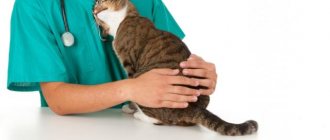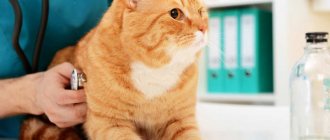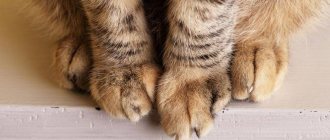If a cat's blood sugar is high, this may be a symptom of hormonal disorders, diseases of the pancreas and liver, or diabetes. High glucose levels are also observed in stressful situations. The owner should know the level of sugar in the animal’s serum and urine and how to monitor the indicators. To normalize the level of the substance, the owner should consult a veterinarian who will prescribe medications and diet.
According to veterinarian Yu. Baburova, in 70% of cases, cats are diagnosed with insulin-dependent diabetes mellitus.
Reasons: why does sugar rise?
The main factors for changes in glucose levels are as follows:
- Endocrine disorders. In cats, acromegaly, hyperthyroidism, and Cushing's syndrome are diagnosed and occur due to dysfunction of the thyroid gland. It is also caused by high production of the hormone cortisol by the adrenal glands. Hormonal imbalance is provoked by poor nutrition (especially feeding chicken necks), iodine deficiency, and tumors of the adrenal cortex.
- Diseases of the liver and pancreas. Such ailments include cholangitis, hepatitis of any etiology, lipidosis, pancreatitis. Pathologies are provoked by poor nutrition, infection with parasites, high levels of calcium in the blood, and uncontrolled use of antibiotics and hormonal drugs by the cat owner.
- Diabetes. A complex of systemic disorders occurs in which the body does not produce insulin. Beneficial substances do not enter organ tissues due to a lack of energy, which occurs only when glucose and insulin interact. The main reason is chronic inflammation of the pancreas.
- Stress. If the animal is nervous, a temporary hormonal imbalance occurs, which leads to an increase in glucose. Stressful situations include moving to a new place, the appearance of a newborn child or another animal in the house, and frequent noisy parties thrown by the owner.
Clinical picture
The symptoms of diabetes mellitus depend on the type of disease. The insulin-dependent form has a pronounced clinical picture. A characteristic symptom is severe thirst due to increased glucose concentrations.
The urinary system cannot cope with the load, so its volume increases. Along with polydipsia (unquenchable thirst), dehydration occurs.
Other symptoms:
- Polyuria. Urine discharge is frequent and painful.
- Increased or lack of appetite.
- Weight loss.
- Change in the appearance of the coat. It loses its shine, fades and looks untidy.
- Tachycardia.
- Diarrhea, vomiting.
- Pungent odor of acetone from urine and skin.
- Lethargy, apathy.
- Loss of coordination.
In severe cases, loss of consciousness and convulsions are noted. The further the disease develops, the worse the animal looks: ulcers appear on the skin, hair falls out, and fatty liver develops.
The second type of diabetes mellitus is characterized by the absence of the smell of acetone, painless but frequent urination, and increased appetite. The cat is losing weight, drinking a lot, but his condition is satisfactory.
Norm and tests: how to control glucose?
If your pet’s level is above 6 mmol/l, then this is a sure sign of hyperglycemia.
The normal proportion of blood sugar in a cat is 3-6.1 mmol/l. Low levels (hypoglycemia) are considered to be below 3 mmol/L. Increased glucose (hyperglycemia) - over 6 mmol/l. The normal level of sugar in urine is 0. Even a slight increase in glucose in urine is a reason to have the animal examined. To do this, a fasting blood test is taken (a small amount of plain water is allowed). However, going to the veterinary clinic is very stressful for a cat, so the indicators may be overestimated.
If diabetes is suspected, the veterinarian recommends that the owner independently measure the pet's glucose daily. Urine test strips (Uriglyuk, Glucofan) or a regular medical glucometer (Accu-Chek Active) are suitable for this. It is better to take blood from the vessels at the end of the animal’s ear, after shaving the hair on the ear. Algorithm of actions:
- Turn on the device and insert the test strip into it.
- Match the code on the packaging and on the device monitor.
- Wait until the drop sign appears.
- Puncture the vessel with a glucometer needle.
- Apply the test strip to the drop of blood so that the liquid is absorbed.
- Place a strip of blood in the device and wait for the readings to appear.
- Treat the injection site with an alcohol solution.
To accurately indicate to the veterinarian the dynamics of increased glucose levels, the owner can keep a special journal where the date, time of the analysis and the indicator are recorded.
Diagnostics: what is it like?
For diabetic nephropathy, standard diagnostic methods are used. Conduct
- biochemical blood test (with electrolytes);
- a general urine test (considered a priority, as it gives reason to think if protein is found there);
- Ultrasound of the kidneys with Doppler (to monitor renal blood flow);
- general blood test (informative at the stage of severe diabetic nephropathy, since severe anemia occurs).
All research at the Ros-Vet EC is carried out in a laboratory located directly on the territory of the center. The results of the tests appear at the nephrologist’s office as soon as possible.
What to do to normalize sugar?
Drug treatment
If prescribed by a veterinarian, the animal can take Metformin.
All medications are prescribed by a veterinarian; self-medication leads to the death of the animal. To keep blood glucose levels normal, drugs that lower sugar levels are used. These include Glipizide, Miglitol, Gliquidone, Metformin. For insulin-dependent diabetes, insulin injections are prescribed. If hyperglycemia is caused by endocrine diseases, hormonal treatment is used, which the veterinarian prescribes individually. For the medications to work well, any stressful situations in your pet’s life should be eliminated. In case of hypoglycemia, you should give the animal a little honey or sugar solution to increase the level of glucose in the blood, and immediately contact the veterinary clinic, since the condition threatens the cat’s life. In addition, concomitant diseases that cause increased sugar should be treated.
Diabetes mellitus in cats
Skomorovsky Kirill Aleksandrovich therapist, endocrinologist, neurologist, DVM, BSc
Diabetes mellitus in dogs, cats and humans has much in common. However, the mechanism that leads to the development of diabetes and its manifestations often differ significantly depending on the animal species. And therefore, approaches to treatment are also not the same in everything.
Therefore, we cannot blindly transfer everything we know about diabetes in humans to dogs. For example, it is incorrect to divide diabetes in dogs into type 1 and type 2 diabetes, as is common in humans. In addition, many drugs that work well in humans work poorly or not at all in animals. There are other differences too. So, we will only talk about dogs.
What happens normally
All cells in our body require glucose (“sugar”) as their main source of energy. Glucose enters the body through the intestines from food or from internal reserves (liver glycogen, muscles, etc.). From the intestines or from internal reserves, glucose is carried to places of consumption by the blood. However, for most cells, it is not enough for the blood to bring them glucose; it is also necessary for a hormone called insulin to transmit the corresponding signal to the cell, and the cell is able to perceive this signal. This hormone is produced in the body in the so-called islets of Langerhanz in the pancreas.
So, after eating, glucose from the intestines enters the blood and its level in the blood increases. The pancreas senses this increase and releases insulin into the blood. The cells of the body perceive the insulin signal and transfer glucose from the blood into the cytoplasm (inside the cells). The level of glucose in the blood drops, the cells feel “full”, and the pancreas stops releasing insulin into the blood.
What happens with diabetes
In diabetes, one or both of the following occurs:
- the pancreas loses its ability to produce enough insulin
- body cells lose the ability to perceive the insulin signal
In both cases, the cells “do not understand” that there is already enough glucose in the blood and do not transport it inside. As a result, blood glucose levels remain high while cells starve. Hence, one of the symptoms of diabetes is high blood glucose.
Normally, the kidneys do not pass glucose from the blood into the urine. However, when blood glucose levels rise above a certain limit, the kidneys cannot cope and glucose begins to be excreted in the urine. Thus, another symptom of diabetes mellitus appears - high glucose in the urine.
When there is a lot of glucose in the urine, it then “pulls” water from the blood. As a result, the volume of urine increases and the animal begins to urinate a lot. Water is removed from the body, the body becomes dehydrated, the animal feels thirsty and begins to drink more. Hence two other symptoms of diabetes: polyuria and polydipsia (excessive drinking and urination).
Since cells cannot bring glucose in, this situation is essentially starvation for the body. It includes compensation mechanisms: the animal becomes hungry and begins to eat more than usual (although this is not beneficial, since glucose remains in the blood and then leaves in the urine), and internal energy reserves are also mobilized. When glycogen stores in the liver and muscles are no longer sufficient, the body begins to use protein and fat reserves. Due to protein breakdown, muscle mass decreases. This is how another symptom of diabetes appears - increased appetite along with weight loss.
With the massive breakdown of fats in the body, many ketone bodies are formed. Ketone bodies can also be found in urine. One of the ketone bodies is acetone, so animals that are seriously ill with diabetes may smell acetone in their breath. In addition, the acidity of the blood increases (pH decreases). This situation is called diabetic ketoacidosis and is critical. Without intensive treatment, it can lead to death in a matter of days, or even hours.
High blood sugar has a detrimental effect on many systems: due to damage to nerve fibers, weakness of the hind limbs and a plantigrade gait appear, and diabetic cataracts occur (the lens of the eye becomes cloudy; it is rare in cats). The presence of sugar in the urine creates excellent conditions for the growth of bacteria, so cystitis is also a common complication of diabetes.
Who has diabetes
It most often appears in cats between 9 and 11 years of age. Neutered cats are more likely to get sick.
What is the reason
In dogs, the main cause is hereditary predisposition.
Without delving into the mechanism of development of diabetes, we can say that in most cases it is impossible to establish the exact cause of its occurrence. However, there are factors that predispose to diabetes and, together, can lead to it.
These factors are:
- overweight
- treatment with hormonal drugs
- pancreatitis
- the period of the first 1-2 months after estrus or pregnancy
- other hormonal disorders.
How to make a diagnosis
To make a definitive diagnosis of diabetes, it is not enough to detect any one of the above-mentioned signs, since for each of them there can be many other causes besides diabetes. For example, polyuria and polydipsia can be caused by chronic renal failure, blood glucose can rise simply from stress, cataracts can simply be “senile”, and increased appetite along with weight loss can be caused by worms. For this reason, if you or your doctor suspects an animal has diabetes, it is often necessary to carry out a whole range of examinations, which are necessary both to make an accurate diagnosis and to detect associated problems and complications. These examinations may include: blood tests (general, biochemical, acid-base balance, serial glucose measurements, hormone tests), urine tests, assessment of the amount of fluid intake and urine output, x-rays, ultrasound, ECG.
What to do next
So, we know that our animal has diabetes mellitus, that is, the body’s cells do not take glucose from the blood inside. In most cases, to overcome the lack of insulin or low sensitivity to it, it is necessary to introduce insulin from outside.
It is impossible to predict in advance exactly how much insulin will be needed for any given animal. However, based on the weight of the animal and previous experience, you can start with a certain dose, and then adjust the amount and frequency of insulin administration in accordance with the body’s reaction. For the most accurate and quick dosage selection, the best way is to construct a glucose curve. To do this, blood glucose is measured every 1-2 hours after insulin administration for 8-24 hours. Thus, you can find out at what interval after administration insulin begins to act, at what period its action peaks, how long and how strongly it acts.
The next step is to select the optimal time to feed the animal. Depending on the type of insulin used (short, intermediate or long-acting), on the type of food and on the individual characteristics of the animal, it may be recommended to feed simultaneously with insulin administration, some time after administration, split and frequent feeding in small portions, or providing constant access to food.
Further observation is carried out by the owner with regular monitoring by the attending physician. The animal's condition may change, insulin sensitivity may increase or decrease, and concomitant diseases may appear. For this reason, it is necessary to periodically come for follow-up examinations, conduct laboratory tests, and sometimes repeat the construction of the glucose curve.
It is necessary for the doctor or assistant to explain in detail and show the owner how to store, how to draw and how to administer insulin.
It is important to remember that the effects of too much blood glucose affect the body gradually, while a drop in blood glucose below normal levels (hypoglycemia) can be fatal very quickly. Therefore, when using insulin, the goal is not to bring glucose to a normal level, but to keep it slightly above the upper limit of normal. This way we will be sure that we will not get hypoglycemia.
For the same reason, it is not as scary to “under-dose” insulin as to overdose it. Therefore, if you injected insulin, but were not sure that you were in the right place (for example, you felt that the fur became wet at the injection site), or you do not know whether someone at home injected insulin before you, never re -inject insulin. It is better to miss an injection once than to inject twice by mistake.
Since there are often some difficulties with purchasing insulin in pharmacies, it is recommended to always have one spare sealed package of insulin at home. It is usually recommended to throw away an opened package of insulin after 1.5-2 months, even if it is not completely used up.
Feeding
Usually, immediately after a meal, glucose in the blood increases very strongly, and the body of a diabetic animal cannot cope with such a load. Therefore, the point of feeding for diabetes is to ensure that the flow of glucose from food into the blood is as slow as possible. This is usually achieved by selecting special sources of dietary fiber in the right proportion. In addition, the food must contain a limited amount of calories and a sufficient amount of protein. The best solution is to feed with special medicated food. If for any reason this is not possible, you should discuss other options with your doctor. As we mentioned above, the frequency and time of feeding are selected individually.
As for the amount of food consumed per day, it is very important to feed the animal in such quantities that it remains thin. Obesity reduces the sensitivity of cells to insulin, which means it worsens diabetes.
When to sound the alarm
If the animal develops weakness, unsteady gait, trembling, loss of consciousness, convulsions, it is necessary to offer the animal to eat (if it is conscious), and if it refuses food, spread honey, sugar syrup or glucose solution on the oral mucosa (tongue, gums). and contact your doctor immediately.
If your blood or urine glucose levels rise above what they were before, you should contact your doctor within 1-2 days.
If the blood glucose level drops below 3 mmol/liter, it is necessary to offer the animal to eat (if it is conscious), and if it refuses food, spread honey, sugar syrup or glucose solution on the oral mucosa (tongue, gums) and immediately contact doctor.
If your urine glucose level drops to zero and/or ketones appear in your urine, you should check your blood glucose levels.
Diabetic ketoacidosis
Diabetic ketoacidosis is a critical condition that usually appears after an animal has had diabetes for a long time. However, in some cases, diabetes can lead to ketoacidosis in a matter of days. As mentioned above, in this state the body mobilizes large amounts of fat as an energy source. The liver forms ketone bodies from these fats, one of which is acetone. This leads to acidification of the blood and can lead to death within a short time.
Symptoms of diabetic ketoacidosis are: the smell of acetone on the breath, lethargy, refusal to eat, vomiting, diarrhea, rapid breathing, low temperature, coma.
If one or more of these symptoms occur, you should contact your doctor immediately.
Treatment of animals in a state of diabetic ketoacidosis consists primarily of insulin and intensive care. In such cases, insulin is used not so much to lower blood glucose levels as to stop the production of ketone bodies in the liver. For this purpose, short-acting types of insulin are used; the drug is administered very often (every 1-2 hours) and under strict control of blood glucose levels. Droppers are needed in order to restore water, acid-base and electrolyte balance in the body, in order to quickly remove ketone bodies from the body, and also to prevent blood glucose from falling below normal due to the administration of insulin in large quantities. doses
Problem cases
If the patient cannot be stabilized for a long time, the reason may be the following:
- incorrect dialing and/or administration of insulin
- ineffective insulin (expiration date has expired or storage conditions have not been met)
- accelerated insulin metabolism (rapid elimination from the body)
- Somogyi effect (too high a dose of insulin can lead first to a sharp drop and then to a strong and prolonged rise in glucose levels)
- simultaneous use of other drugs (especially hormones)
- changes in internal hormonal levels (sexual cycle in bitches, hyper- and hypo-adrenocorticism, acromegaly, etc.)
- concomitant infections (in particular, cystitis, periodontal disease, dermatitis) and other diseases
- obesity (see above)
- true insulin resistance
- excess fats in the blood
- antibodies against insulin.
What can you do besides insulin?
In most cases, no drug can replace insulin in the treatment of canine diabetes. However, there are a number of measures that can, if not eliminate, then at least significantly reduce the need for insulin in animals. For female dogs, such an event is, first of all, sterilization (removal of the uterus and ovaries). If diabetes appears during the first two months after estrus or pregnancy, then sometimes spaying or simply ending this period completely relieves the animal of the symptoms of diabetes. However, the predisposition to diabetes remains, and it can reappear at any time.
Another important point regarding obese animals is reducing body weight to normal. It is also important to increase the animals’ physical activity (walk longer and play with dogs).
You should switch to feeding special medicinal foods (Hill's w/d, Royal Canin Diabetic, etc.).
Use of oral hypoglycemic agents
Glipizide (as well as glyburide and glibenclamide) – enhances the production of insulin by the pancreas. This drug is not effective in treating canine diabetes. Metformin - increases tissue sensitivity to insulin, and also reduces the release of glucose from the body's internal reserves and the synthesis of glucose in the body.
Metformin could possibly help animals that retain some ability to produce insulin, but side effects (lethargy, loss of appetite, vomiting) limit its use. At this stage, additional research is required to draw conclusions about the feasibility of its use.
Vanadium is an element found everywhere. It probably has insulin-like properties and is virtually free of side effects, but is nonetheless ineffective on its own. Vanadium was studied in the form of dipicolinate. This form is not available for purchase. Vanadium sulfate is sold as a vitamin supplement, but its effectiveness is unknown.
Chromium – in the form of picolinate, enhances the effect of insulin in healthy dogs. However, this effect was not observed in dogs with diabetes.
Acarbose - inhibits digestive enzymes responsible for breaking down starches (the main sources of glucose in the intestines). As a result, glucose enters the intestines more gradually and more even glucose levels are maintained in the blood. The drug is expensive and has side effects (diarrhea, weight loss), so it is used in dogs only if insulin alone is not enough to control hyperglycemia.
Troglitazone – increases tissue sensitivity to insulin











